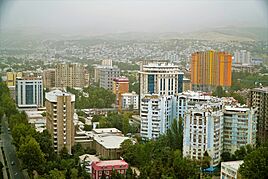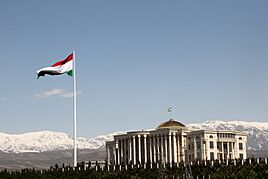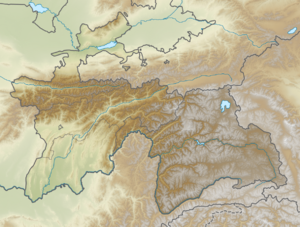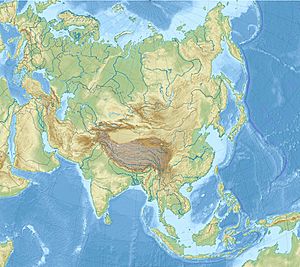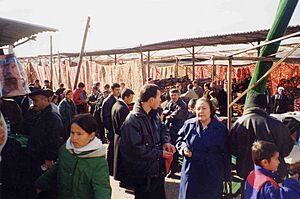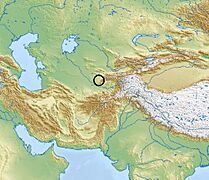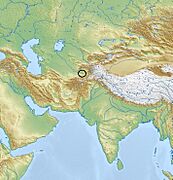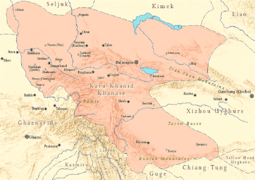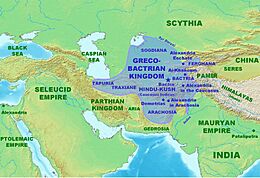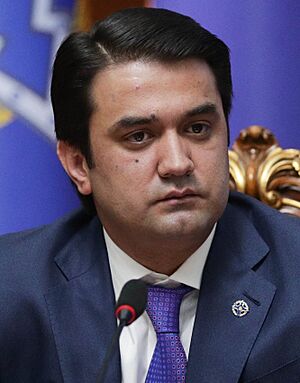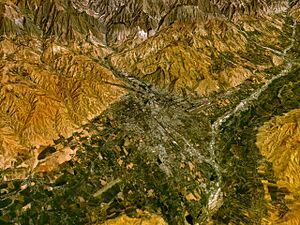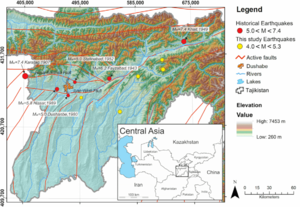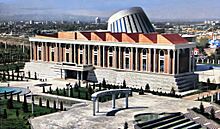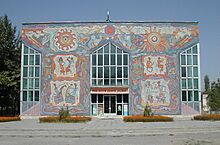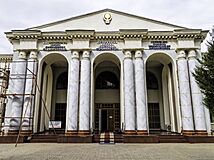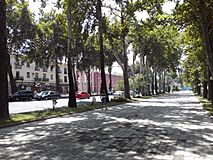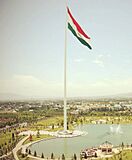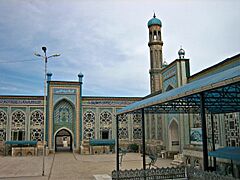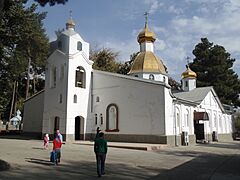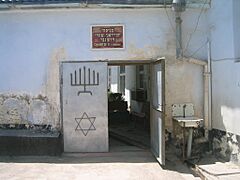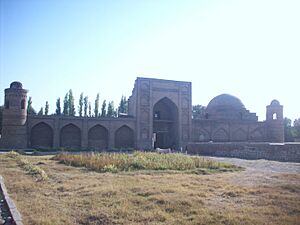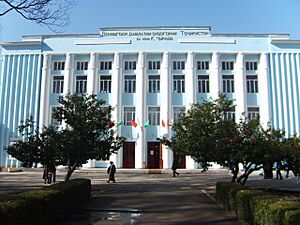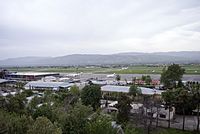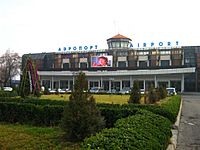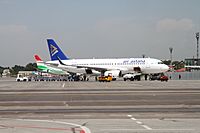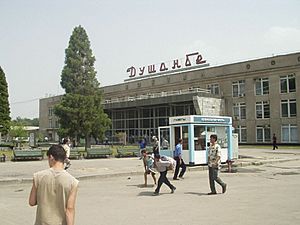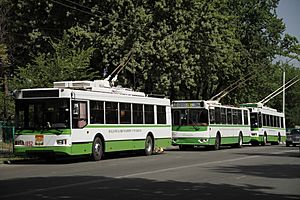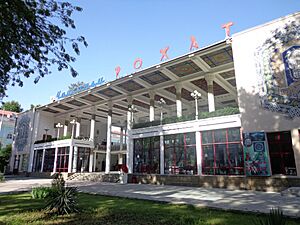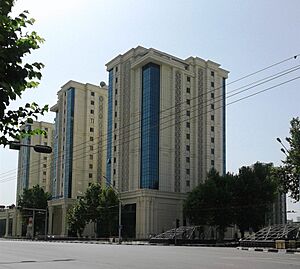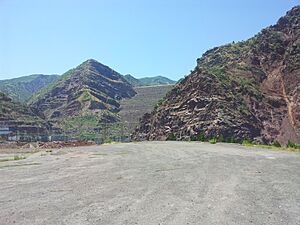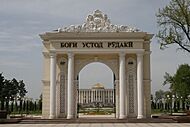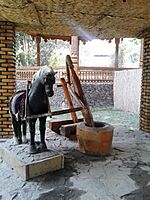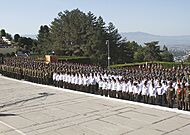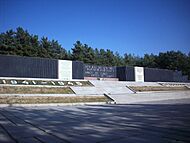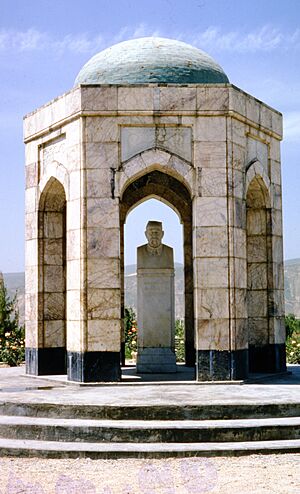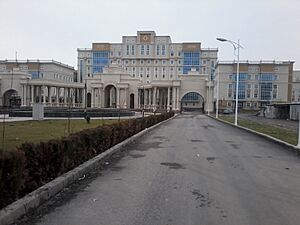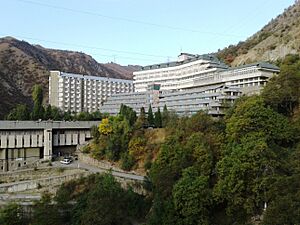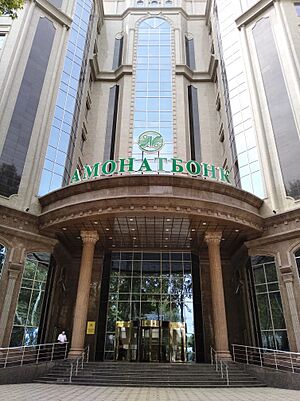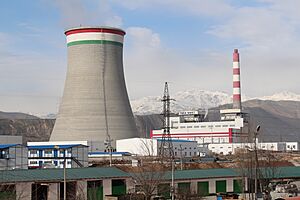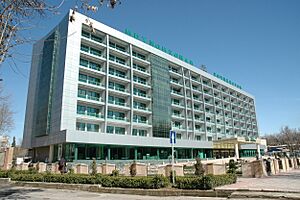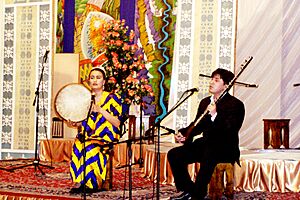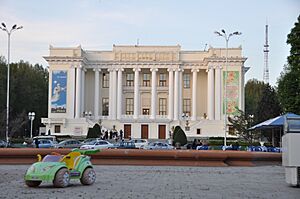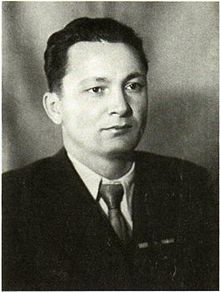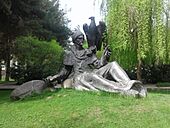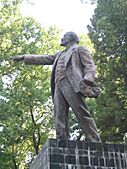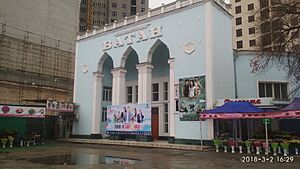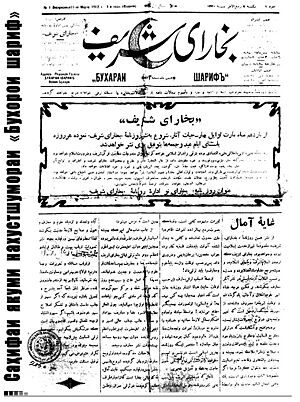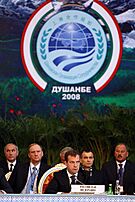Dushanbe facts for kids
Quick facts for kids
Dushanbe
Душанбe (Tajik)
|
||
|---|---|---|
|
Dushanbe skyline
Tajikistan National Museum
Statue of Rudaki
National Library of Tajikistan
Ayni Opera House
Palace of the Nation and Dushanbe Flagpole
|
||
|
||
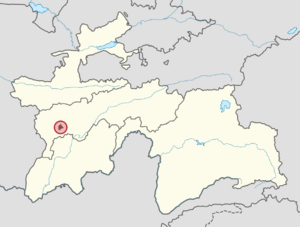
Location of Dushanbe in Tajikistan
|
||
| Country | ||
| Region | Dushanbe | |
| Named for | Monday | |
| Area | ||
| • Land | 203 km2 (78 sq mi) | |
| • Urban | 185 km2 (71 sq mi) | |
| Elevation | 823 m (2,700 ft) | |
| Highest elevation | 930 m (3,050 ft) | |
| Lowest elevation | 750 m (2,460 ft) | |
| Population
(March 2024)
|
||
| • Capital city | 1,564,700 | |
| • Rank | 1st in Tajikistan | |
| • Metro | 3,147,000 | |
| Time zone | UTC+05:00 (TJT) | |
| Postal code |
6-Digit
|
|
| Area code(s) | 372 | |
| Vehicle registration | 01, 05 | |
| HDI (2021) | 0.756 high |
|
| Official languages | ||
Dushanbe is the capital and largest city in Tajikistan. As of March 2024, about 1,564,700 people live there. Most of the people are Tajik.
Before 1929, the city was called Dyushambe. From 1929 to 1961, it was known as Stalinabad, named after Joseph Stalin. Dushanbe is in the Gissar Valley. Mountains surround it on all sides. The city sits at an elevation of 750–930 meters (2,460–3,050 feet). Dushanbe is divided into four main areas: Ismail Samani, Avicenna, Ferdowsi, and Shah Mansur.
Long ago, different groups lived in or near what is now Dushanbe. These included early tool-users, ancient farming cultures, and powerful empires like the Achaemenid Empire and the Kushan Empire. In the Middle Ages, new towns grew nearby. Dushanbe itself became a market village. It was controlled by different rulers before the Russian Empire took over.
In 1922, the Bolsheviks took control of Dushanbe. In 1924, it became the capital of the Tajik Autonomous Soviet Socialist Republic. This led to Dushanbe growing very quickly. This growth continued until the Tajik civil war. After the war, Dushanbe became the capital of independent Tajikistan. It kept growing into a modern city. Today, it hosts many international meetings.
Dushanbe's education system started mostly during Soviet times. The government still controls it a lot. The biggest university, the Tajik National University, gets money from the government. Dushanbe International Airport is the main airport. Other ways to get around include trolleybuses, a small train system, and roads. Dushanbe gets most of its electricity from hydroelectric power, mainly from the Nurek Dam. The city's healthcare system is very important for Tajikistan. Dushanbe creates 20% of Tajikistan's total economic output. It has big industries, finance, shops, and tourism. Famous places to visit include Victory Park, Rudaki Park, the Tajikistan National Museum, the Dushanbe Flagpole, and the Tajikistan National Museum of Antiquities.
Contents
What's in a Name?
Dushanbe got its name because it had a big market that opened every Monday. The name Dushanbe means Monday in the Persian language. It literally means "the second day" (du) after Saturday (shanbe). So, it was like "Monday Market."
In late 1929, the city was renamed Stalinabad, meaning "the city of Stalin." But in late 1961, it changed back to Dushanbe. This happened during a time when many places were removing Stalin's name.
City History
Early Times
Long, long ago, in the Stone Age, people lived in the Hisar Valley near Dushanbe. Later, different ancient cultures lived there. They used stone tools and were good at raising cattle, farming, and weaving.
Near Dushanbe International Airport, archaeologists found Bronze Age burial sites. These date back to about 1000 BC. The Achaemenid Empire controlled the area from the sixth century BC. Later, the Seleucid Empire took over in 312 BC. A small Greco-Bactrian settlement was found from around 300 BC. Coins from this time have also been discovered.
The Kushan Empire also had a city near the Varzob River from the 2nd to 3rd centuries AD. They built other settlements too. Later, the Sasanian Empire and the Hephthalites were in control. Ruins of a Buddhist monastery from the 5th-6th centuries, called Ajina Tepe, are near Dushanbe. Trade became important during this period.
After the Arab conquest, the Samanids ruled the region. Crafts and trade grew. In the 10th-12th centuries, the medieval city of Hulbuk developed nearby. It had a famous palace.
A Growing Market Town
Dushanbe was first mentioned in history in 1676. It was called "Kasabai Dushanbe," meaning "Dushanbe Town." This name showed its importance as a town and a trading center. Its location on major caravan routes helped its market grow. Traders traveled through Dushanbe to places like Bukhara, Samarkand, and Afghanistan. At that time, about 7,000–8,000 people lived there.

By 1826, the town was called Dushanbe Qurghan, meaning "Dushanbe Fortress." It became known as Dyushambe in Russian in 1875. It was a stop for travelers and had many mosques, schools, and teahouses. The town was a center for weaving, leather making, and iron production.
In 1920, the last ruler of Bukhara, Mohammed Alim Khan, came to Dushanbe after being overthrown. But the Red Army took over the area in 1921. Dushanbe became part of the Bukharan People's Soviet Republic.
Capital of the Tajik ASSR
In October 1924, Dushanbe became the capital of the Tajik Autonomous Soviet Socialist Republic. This was part of the Uzbek Soviet Socialist Republic. Dushanbe was chosen because it was a central meeting place with a large market. Its mild climate was also a factor.
Before Soviet rule, Dushanbe had a small Jewish community. They were involved in trade. After the Red Army took control, the Jewish population grew. In 1923, Dushanbe got its first telegraph link. A railroad to Termez was started, and a telephone system was set up in 1924. The first newspaper, Voice of the East, was published in 1924. Electricity also came to Dushanbe around this time. The railroad was finished in November 1929. This helped the city's economy grow a lot. The first boarding school for boys opened in 1925.
Capital of the Tajik SSR
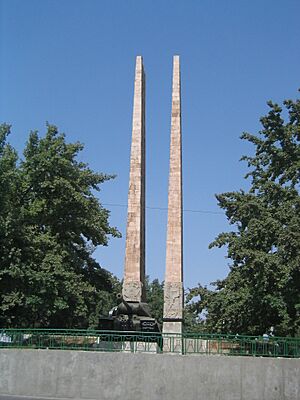
In 1929, the Tajik Soviet Socialist Republic became separate from the Uzbek SSR. Its capital, Dyushambe, was renamed Stalinabad on October 19, 1929. This included nearby villages.
The city grew very fast. The Soviets turned the area into a center for cotton and silk. Thousands of people moved to the city. Many Tajiks from Uzbekistan also moved to Tajikistan. Industries grew, focusing on local products. The first bus line started in 1930. In 1938, young people built Komsomolskoye Lake in the city.
During World War II, Dushanbe's population increased with people moving from the war zones. The city's industries also grew a lot. This was because the Soviets moved important factories away from the front lines. Industries like textile and food processing expanded. By 1954, Dushanbe had 30 schools and several universities. In 1960, natural gas came to the capital. On November 10, 1961, Stalinabad was renamed Dushanbe again. In 1960, the first zoo was built.
The Nurek Dam, a very tall dam, was finished near Dushanbe in the 1960s. It was a huge project to show Soviet progress.
Unrest and Independence
In the 1980s, problems like crime and environmental issues increased. In February 1990, riots broke out in Dushanbe. People were worried about housing shortages. There were rumors that Armenian refugees would take homes. Violence occurred, and many people were killed.
After these events, Tajikistan's government declared independence from the Soviet Union on September 9, 1991.
Capital of Independent Tajikistan
Dushanbe became the capital of independent Tajikistan on September 9, 1991. Other countries soon opened embassies there.
During the Tajikistani Civil War (1992–1997), Dushanbe was mostly controlled by the government. However, opposition groups did capture the capital for a short time in 1992. Many Russians left the city during the war, and more rural Tajiks moved in. The war ended with a peace agreement in 1997.
In 2000, Dushanbe got internet access. In 2004, UNESCO named Dushanbe a "city of peace." Rustam Emomali, the son of the current President, became Mayor of Dushanbe in January 2017. Since independence, the city's economy has grown steadily.
Geography and Climate
Dushanbe is where two rivers meet: the Varzob River and the Kofarnihon River. It is between 750 and 930 meters (2,460–3,050 feet) above sea level. Mountains surround the city, making it a basin. Most of Dushanbe's buildings are in the valley.
Dushanbe is in an area where earthquakes can happen. Strong earthquakes have been felt in the city over the last 100 years.
Weather in Dushanbe
Dushanbe has a Mediterranean climate. This means it has hot summers and cool winters. It gets more rain than other Central Asian capitals, especially in winter and spring. The mountains protect the city from very cold winds from Siberia.
Winter usually starts in early December and ends in late February. Spring is from late February to mid-May. This is when most rain, thunderstorms, and hail occur. Summer is from mid-May to mid-August. It is hot and dry, which is good for farming. A warm, dry autumn follows.
| Climate data for Dushanbe (1991–2020, extremes 1926–present) | |||||||||||||
|---|---|---|---|---|---|---|---|---|---|---|---|---|---|
| Month | Jan | Feb | Mar | Apr | May | Jun | Jul | Aug | Sep | Oct | Nov | Dec | Year |
| Record high °C (°F) | 21.8 (71.2) |
27.7 (81.9) |
32.2 (90.0) |
36.2 (97.2) |
38.8 (101.8) |
44.1 (111.4) |
43.7 (110.7) |
45.0 (113.0) |
38.9 (102.0) |
36.8 (98.2) |
31.9 (89.4) |
24.3 (75.7) |
45.0 (113.0) |
| Mean daily maximum °C (°F) | 9.0 (48.2) |
11.0 (51.8) |
17.0 (62.6) |
22.8 (73.0) |
27.9 (82.2) |
33.6 (92.5) |
36.4 (97.5) |
35.5 (95.9) |
31.3 (88.3) |
24.4 (75.9) |
16.7 (62.1) |
11.1 (52.0) |
23.1 (73.6) |
| Daily mean °C (°F) | 3.1 (37.6) |
5.0 (41.0) |
10.5 (50.9) |
15.8 (60.4) |
20.1 (68.2) |
25.1 (77.2) |
27.4 (81.3) |
26.0 (78.8) |
21.2 (70.2) |
14.7 (58.5) |
9.0 (48.2) |
4.6 (40.3) |
15.2 (59.4) |
| Mean daily minimum °C (°F) | −0.9 (30.4) |
0.5 (32.9) |
5.5 (41.9) |
10.1 (50.2) |
13.4 (56.1) |
17.2 (63.0) |
18.9 (66.0) |
17.2 (63.0) |
12.7 (54.9) |
7.8 (46.0) |
3.8 (38.8) |
0.4 (32.7) |
8.9 (48.0) |
| Record low °C (°F) | −26.6 (−15.9) |
−17.6 (0.3) |
−12.9 (8.8) |
−6.1 (21.0) |
1.2 (34.2) |
8.4 (47.1) |
10.9 (51.6) |
8.2 (46.8) |
−1.0 (30.2) |
−4.4 (24.1) |
−13.5 (7.7) |
−19.5 (−3.1) |
−26.6 (−15.9) |
| Average precipitation mm (inches) | 61 (2.4) |
94 (3.7) |
103 (4.1) |
114 (4.5) |
77 (3.0) |
17 (0.7) |
3 (0.1) |
1 (0.0) |
4 (0.2) |
29 (1.1) |
55 (2.2) |
60 (2.4) |
618 (24.4) |
| Average precipitation days (≥ 1.0 mm) | 8.5 | 9.1 | 13.4 | 9.8 | 7.8 | 1.5 | 0.7 | 0.1 | 0.8 | 3.7 | 5.3 | 8.1 | 68.8 |
| Average relative humidity (%) | 69 | 67 | 65 | 63 | 57 | 42 | 41 | 44 | 44 | 56 | 63 | 69 | 57 |
| Mean monthly sunshine hours | 120 | 121 | 156 | 198 | 281 | 337 | 352 | 338 | 289 | 224 | 164 | 119 | 2,699 |
| Source 1: Pogoda.ru.net | |||||||||||||
| Source 2: Deutscher Wetterdienst (humidity 1951–1993 and precipitation days 1961–1990) NOAA (sun, 1961–1990) | |||||||||||||
Plants and Animals
Before the 20th century, Dushanbe had natural plants like almond bushes. But as the city grew, most of this natural plant life was removed. Now, the city has a "green belt" and a botanical garden. These areas have brought new plants to the city. Dushanbe has over 150 types of trees and shrubs. Only about 15 of these are native to the area. About 22% of the city is green space.
There are 14 types of mammals in Dushanbe, including foxes, weasels, and different kinds of bats and rodents. The city is home to 130 bird species, like rock pigeons and turtle doves. Many migratory birds visit in fall and summer. Dushanbe also has 47 types of reptiles, such as geckos, snakes, and lizards. Amphibians like frogs and toads live in the city's cleaner waters. The rivers, lakes, and ponds have 14 types of fish, including carp and goldfish. About 300 types of insects live in the city, mostly cicadas, beetles, and butterflies.
City Districts
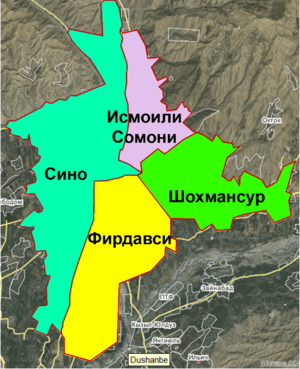
Dark Green: Shah Mansur
Purple: Ismail Samani
Light Green: Avicenna
Yellow: Ferdowsi
Dushanbe is divided into four main districts:
| District name | Former name | Area,
km2 (2020) |
Population,
persons (as of previous 2019 borders) |
District Chairman |
|---|---|---|---|---|
| Ismail Samani (Tajik: Исмоили Сомонӣ, Ismoili Somoni) | October (Октябрьский) | 37.6 | 148,700 | Sami Sharif Hamid |
| Avicenna (Sino) (Tajik: Абӯалӣ Ибни Сино, Abūali Ibni Sino) | Frunzensky (Фрунзенский) | 62.2 | 326,100 | Salimzoda Nusratullo Faizullo |
| Ferdowsi (Tajik: Фирдавсӣ, Firdavsi) | Central (Центральный) | 54.5 | 209,000 | Yusufi Muhammadrahim |
| Shah Mansur (Tajik: Шоҳмансур, Shohmansur) | Railway (Железнодорожный) | 48.9 | 162,600 | Bilol Ibrohim |
In 2020, the city's borders grew to include land from Rudaki District.
Main Sights
Some of Dushanbe's most famous places include the Tajikistan National Museum and the National Museum of Antiquities of Tajikistan. You can also visit the Ismaili Centre and Vahdat Palace. The Dushanbe Flagpole is the second tallest free-standing flagpole in the world. Other sights are the Dushanbe Zoo, Rudaki Avenue (the main street), the Gurminj Museum of Musical Instruments, and the National Library. The library is the largest in Central Asia, with over 3 million books.
- Main sights of Dushanbe
People of Dushanbe
The population of Dushanbe grew quickly after the Soviet era began. It decreased during the Tajik Civil War in the 1990s. But it started growing again after the war. In the mid-20th century, many people in the city were Russian or from Eastern Europe. After the civil war, many Russians left, and the Tajik population became the majority. In 2014, the average life expectancy in Dushanbe was 74.1 years.
| Year | Tajik | Russian | Uzbek | Tatar | Ukrainian | Jewish | Korean | German | Turkmen | Kirghiz | Kazakh | Other |
|---|---|---|---|---|---|---|---|---|---|---|---|---|
| 1939 | 12.05 | 56.95 | 9.02 | 4.71 | 5.95 | 4.09 | .01 | .46 | 0.05 | 0.11 | 0.42 | 6.18 |
| 1959 | 18.7 | 47.83 | 10.31 | 5.5 | 4.4 | 3.88 | 0.14 | 3.55 | 0.05 | 0.11 | 0.17 | 5.36 |
| 1970 | 26.4 | 41.92 | 10.26 | 5.13 | 3.54 | 3.04 | 0.87 | 3.62 | 0.08 | 0.14 | 0.15 | 4.85 |
| 1979 | 31.61 | 38.51 | 10.03 | 4.73 | 3.59 | 2.26 | 1.01 | 3.09 | 0.11 | 0.14 | 0.15 | 4.77 |
| 1989 | 39.13 | 32.37 | 10.43 | 4.09 | 3.55 | 2 | 1.10 | 2.28 | 0.12 | 0.17 | 0.18 | 4.58 |
| 2000 | 84.4 | 5.1 | 9.1 | .7 | .3 | .02 | .06 | 1.32 | ||||
| 2003 | 83.4 | 5.1 | .7 | .3 | .1 | 1.1 | 9.3 | |||||
| 2010 | 89.5 | 2.63 | 6.71 | 0.26 | .1 | 0.08 | 0.03 | 0.7 |
The main languages spoken in Dushanbe are Tajik and Russian. Uzbek is also widely spoken by a minority.
Religions
Islam came to Dushanbe in the 8th century. Today, most people in the city follow Sunni Islam. There is a small Catholic community and a Jewish community. The Dushanbe Synagogue was rebuilt in 2008.
In 2009, Dushanbe was recognized as the 2010 capital of Islamic culture. A new central mosque, funded by Qatar, began construction in 2011. It is planned to be the largest in Central Asia. The Russian Orthodox Church also has a presence in the city. St. Nicholas Cathedral is a place of worship for the Orthodox community.
- Religious buildings in Dushanbe
Education in Dushanbe
Before Soviet times, education in Dushanbe was mostly in religious schools called madrasas. They taught the Quran and other subjects. The Soviet Union later closed these madrasas.
The Soviet education system was very successful. It helped almost everyone learn to read and write. Girls were also included in education. The first higher education schools started in the 1930s. These included a teaching institute and a medical institute. By 1990, the Technological University of Tajikistan was founded.
The civil war after independence greatly affected education. Government spending on schools dropped a lot. However, private schools and universities started to grow.
Today, Dushanbe has many universities and colleges. About 60% of all university students in Tajikistan study in Dushanbe. The Tajik National University is the most important university in the country. It has over 21,000 students. The government funds this university directly. Other schools include the Tajik Technical University and the Tajik Agrarian University. There are also branches of Russian universities in Dushanbe.
Getting Around Dushanbe
Air Travel
The first flight to Dushanbe happened on September 3, 1924. It came from Bukhara. This service ran three times a week. In 1927, another air route opened from Tashkent to Dushanbe. A small airport was built, and a larger one was constructed in 1930. The state airline, Tajik Air, was created in 1949.
-
Air Astana plane at Dushanbe International Airport
Today, Dushanbe International Airport has regular flights to many cities. These include places in China, Afghanistan, India, Dubai, Turkey, Germany, and major cities in Russia and Central Asia. Somon Air, another airline, also has its main office in Dushanbe.
Roads
The first modern road in the country was built by the Soviets. The first bus line started in 1930, and taxi service began in 1937. Cars are the main way people travel in Dushanbe. One important road goes through the mountains from Khujand to Dushanbe. Another major road goes east from Dushanbe towards China and Kyrgyzstan. Many new highways and tunnels have been built or are being built.
Train Travel
The first train line in Dushanbe was built from 1926 to 1929. It connected Dushanbe to Termez and then to Moscow. In 2002, a new railway administration updated the system.
Today, Tajikistan's main railways are in the southern part of the country. They connect Dushanbe to industrial areas and to Uzbekistan, Turkmenistan, Kazakhstan, and Russia. A new train line from Dushanbe to Gharm was built. This line connects the country to Russia, Kazakhstan, and Kyrgyzstan without going through Uzbekistan. There is also a train service from Dushanbe to Khujand.
Trolleybus System
The Dushanbe trolleybus system started on April 6, 1955. The first trolleybus began operating on May 1, 1955. More routes were added over the years. When the Soviet Union broke apart, the system faced problems. The number of trolleybuses dropped a lot. However, 100 new trolleybuses were ordered in 2004, which helped bring the service back.
In 2020, the European Bank for Reconstruction & Development provided money to fix the system. Dushanbe currently has 7 trolleybus routes. They carry millions of passengers each year.
City Infrastructure
Buildings and Design
Before the Soviet era, Dushanbe had narrow streets and mud-brick buildings. None of these old buildings remain. The city's development in the 1920s laid the foundation for its future. In the 1930s, a style called constructivist architecture became popular. Larger buildings, often made of concrete, were built. A master plan for Dushanbe's construction was approved in 1938.
In the 1940s, buildings focused more on decoration and a neoclassical style. After 1955, architecture became more modern and simple. In 1966, a new master plan was created because the city was growing so fast. The first skyscraper in Dushanbe, the Hotel Dushanbe, was built in 1964.
In the 21st century, new tall buildings, a new parliament, and the national museum have been built. However, many older Soviet-era buildings have been torn down. Today, the city center has wide streets and Russian-style buildings.
Electricity
In the 1930s, hydroelectricity became important in Dushanbe. Today, 96% of Tajikistan's power comes from hydroelectricity. Dushanbe has faced energy shortages during winters since 2007. The Nurek Dam provides about three-quarters of the country's power. New hydroelectric plants are being planned.
Water and Cleanliness
Tajikistan has a lot of water from rivers, lakes, and glaciers. Most of Dushanbe's water system was built in 1932 during the Soviet era. It has not been greatly expanded since then, even with more people living in the city. The Big Gissar Canal, built in 1942, helps water many areas. As of 2018, about 40% of the city's population did not have access to modern sewage systems.
Parks
As of 2020, Dushanbe has 15 parks. One famous park is Rudaki Park, created in the 1930s. It was updated in 2007. Another important park is Victory Park. It was built in 1975 to remember World War II. The Botanical Garden of the Academy of Sciences of Tajikistan was founded in 1933. It has many old trees.
- Parks in Dushanbe
Cemeteries
Dushanbe has 5 main cemeteries and 14 smaller ones. Luchob cemetery is one of the main ones. It is where many famous people are buried, like Jabbor Rasulov and Mirzo Tursunzoda. Sari Osiyo is another old cemetery, founded in 1933. The Christian cemetery is also one of the main ones. The Jewish cemetery is looked after by the Congress of Bukharian Jews.
Healthcare
In 1925, Dushanbe got its first city hospital and ambulance service. Many medical places opened during that time. In 1939, an infectious disease hospital and a medical institute were created. The healthcare system grew a lot until the Tajik Civil War.
Tajikistan's healthcare is mostly in Dushanbe. The city has a good network of clinics, hospitals, and medical centers. As of 2010, there were 62 medical facilities in the city. By 2019, the number of hospitals grew to 43. Citizens get care through their assigned clinics. Some hospitals include the Mansurov Clinic and the Istiqlol Medical Complex. Khoja Obi Garm, a Soviet-era health resort, is still open today.
Economy
In 2018, Dushanbe's economy was worth about $1.5 billion. This was about 20.1% of Tajikistan's total economic output. The average salary in the city in 2014 was about $140. Dushanbe is the financial center of Tajikistan. It has over 30 commercial banks.
Dushanbe does a lot of international trade. In the first half of 2019, its exports were worth over $8 million. Its main export partners are Turkey, Iran, and Russia. For imports, Russia, Kazakhstan, and China are the biggest partners.
After the Soviet era began, most industries in Dushanbe focused on local needs. These included meat packing, soap making, and clothing. During World War II, the city's industry grew a lot. This was because factories were moved from the war zones to Dushanbe. About one-third of Tajikistan's industrial workers are in Dushanbe. In 2019, there were 455 manufacturing companies in Dushanbe. They produced many different products.
The main industrial products exported from the city are cotton yarn, cotton fabrics, and tobacco products. Light industry is very important in the city. Companies like Nassoch process cotton. The electrical and engineering industries are also big. The food processing industry has many wineries, dairies, and bakeries. Other industries include building materials, wood, and printing.
In 2014, the retail sector had transactions worth $2.6 billion. The service sector, including hotels and restaurants, also did well.
Dushanbe is a capital for tourism in the Economic Cooperation Organization. It has over 40 hotels. Nine new modern hotels are being planned. Many efforts have been made to promote tourism. These include festivals and new laws. However, Dushanbe is less popular for tourists than other parts of the country. This is partly because it is a newer city. Museums like the Tajikistan National Museum and the Gurminj Museum of Musical Instruments are popular.
Culture
Dushanbe's culture grew under Soviet rule. Many of the city's first cultural places were built then. After independence, Dushanbe's culture became more focused on Tajik national identity.
Performing Arts
Shashmaqam was a popular music style in the 19th century. It is now gaining more popularity. During the Soviet period, music in Dushanbe was encouraged. The Tajik Philharmonic Society was founded in 1938. Many Russian and Ukrainian musicians moved to Dushanbe during World War II.
The Tajik Opera and Ballet Theater was founded in 1936. It was the first opera house in Dushanbe. The first opera performed was about a peasant revolt. Many famous singers performed there. Another orchestra in Dushanbe is the Opera Orchestra. The State Symphony Orchestra of Tajikistan was founded in 2016. The Tajik Opera and Ballet Theater still performs today.
The first ballet in Dushanbe was performed in 1941. The ballet group grew over time. The theater was updated in 2009.
Drama also started in the city in the 1920s. The first theater, Lahouti theater, was built in 1929. Plays often focused on Soviet ideas like class struggle. A comedy group was created in 1944. After independence, plays often focused on the civil war. Today, there are several theaters, including the State Russian Drama Theater and the republican puppet theater.
Literature
The first printing press in Tajikistan was created in 1924. In 1925, 4 books were printed. This number grew quickly. In 1930, Sadriddin Ayni wrote the first Tajik novel. Publishing houses helped increase book production.
Dushanbe became a center for Tajik literature in the 1920s. Writers like Sadriddin Ayni and Abolqasem Lahouti were important. Children's books and translated works also began during this time. In the 1930s, young Russian writers influenced the city's literature. Their stories often described Dushanbe's rapid growth.
During World War II, literature focused on patriotic themes. After the war, novels and poetry became more popular. Literary criticism also developed. In the 1960s, science fiction began in the city. After independence, topics like religion appeared in literature. Writers also reflected on the civil war.
Visual Arts
Sculpture came to Dushanbe in the 1920s. It often combined modern culture with classical heritage. Modern sculptures usually show historical figures. These include Firdavsi and Ismail Samani. They often celebrate Tajik national identity.
- Statues in Dushanbe
-
Statue of Rudaki
-
Statue of Omar Khayyam
-
Statue of Lenin
-
Statue of Avicenna
Painting in Dushanbe grew when Russian painters moved there in the 1920s and 1930s. By the 1950s, Tajik artists started painting. In the 1960s, a "severe style" became popular. In the 1970s and 1980s, artists focused on Tajik heritage and nationalism. During the civil war, paintings often showed themes of conflict.
Movies
Movies in Dushanbe started in the 1930s. The Soviet government built film studios and cinemas. Komil Yarmatov was the first important Tajik film director. Documentaries were popular. The first full-length movie appeared in 1938. During World War II, movie production stopped due to lack of supplies. After the war, more full-length movies were made.
In the 1980s, new filmmakers brought new ideas. They focused on the truth of Soviet history. During the civil war, the movie industry changed a lot. Tajikfilm, which used to control filmmaking, had to close. Independent filmmakers started making movies about the civil war.
Sports
Sports like gymnastics, horse riding, and athletics were practiced in Dushanbe in 1923. Tennis was introduced in 1929. In 1939, Dynamo Dushanbe won a quarterfinal in the Soviet Cup. In 1950, the country's soccer team won first place in the Central Asian Games.
In 2003, Dushanbe hosted the Central Asian Games. The most popular sports in Dushanbe include sambo, wrestling, judo, karate, and football. Four soccer teams from the Tajikistan Higher League play in Dushanbe. The Pamir Stadium was built in 1939. A new Dushanbe Stadium is being built and will hold 30,000 people.
Media
Newspapers and Magazines
The first newspaper published in Tajik was Bukhara Sharif in 1912. It aimed to spread knowledge and ideas. However, it was soon closed.
The first Soviet newspaper in Tajikistan was Shulai Inkilob (Flame of the Revolution) in 1919. It supported the Soviet government. In 1924, Voice of the East was published in Dushanbe. It was a place for poetry and literature. In 1929, the newspaper Red Tajikistan began printing. Many other newspapers were published during this time.
During World War II, newspaper production was difficult. After the war, many newspapers started again. In the 1960s and 1970s, Communist of Tajikistan became very popular.
During a time of change in the Soviet Union, newspapers started to share more liberal ideas. Farkhang, a new literary magazine, published Tajik and Islamic literature that was previously banned. Charogi Ruz, or Light of Day, was the first private newspaper in Dushanbe. Today, it is known for criticizing the government.
In 1999, there were 199 newspapers, but only 17 appeared regularly. Some widely read government newspapers are Dzhumhuriet and Narodna Gazeta. Private newspapers like Asia-Plus also report on important issues. In 2019, there were 37 regular newspapers and 37 magazines published in the city.
Radio
In 1924, a radio station was built in Dushanbe for military use. On April 10, 1930, the first radio broadcast for civilians was heard from Moscow. It provided news and Soviet information. Radios became more common in the country. After World War II, Tajikistan got better radio stations.
In 1977, local radio broadcasts could be sent from Dushanbe. This was thanks to a new Radio House. Today, Sadoi Dushanbe Radio is one of the four programs broadcast in Dushanbe. Government radio is broadcast throughout the nation. Independent stations like Asia Plus radio also exist.
Television
On November 7, 1959, the first television center was created. It was called the Tajik Television Studio. In 1967, programs from Moscow and Tashkent were broadcast. Color television was introduced on November 15, 1975. As of 1999, 12 to 15 stations broadcast regularly. Many Russian language channels also broadcast. Today, more private television stations operate in the city. There are also 7 state-owned channels.
Famous People
- Zebo Aminzoda (born 1948), Tajikistani ballet dancer
- Viktor Bout (born 1967), Russian arms dealer
- Farruh Negmat-Zadeh (born 1959), Tajikistani artist
- Zoya Tajikova (born 1935), Tajik music expert
- Vazgen Manasyan (1958–2024), Tajikistani football coach and player
International Connections
Sister Cities
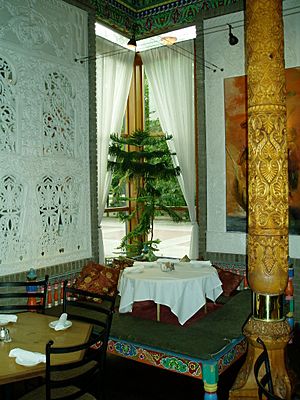
Dushanbe is connected with many cities around the world. These are called sister cities:
 Ankara, Turkey
Ankara, Turkey Ashgabat, Turkmenistan
Ashgabat, Turkmenistan Astana, Kazakhstan
Astana, Kazakhstan Baku, Azerbaijan
Baku, Azerbaijan Boulder, United States
Boulder, United States Doha, Qatar
Doha, Qatar Hainan, China
Hainan, China Islamabad, Pakistan
Islamabad, Pakistan Klagenfurt, Austria
Klagenfurt, Austria Lahore, Pakistan
Lahore, Pakistan Lusaka, Zambia
Lusaka, Zambia Mazar-i-Sharif, Afghanistan
Mazar-i-Sharif, Afghanistan Minsk, Belarus
Minsk, Belarus Monastir, Tunisia
Monastir, Tunisia Qingdao, China
Qingdao, China Reutlingen, Germany
Reutlingen, Germany Saint Petersburg, Russia
Saint Petersburg, Russia Sanaa, Yemen
Sanaa, Yemen Shiraz, Iran
Shiraz, Iran Tehran, Iran
Tehran, Iran Ürümqi, China
Ürümqi, China Xiamen, China
Xiamen, China
In 1982, people from Boulder, Colorado, started an idea to make Dushanbe a sister city. This happened even though the US and the Soviet Union were on opposite sides of the Cold War. In 1987, the mayor of Dushanbe officially made Boulder a sister city. Students, tourists, and artists started to visit between the two cities. The Tajik Teahouse was sent from Dushanbe to Boulder in 1990. During the civil war, Boulder sent help to Dushanbe.
International Meetings
Dushanbe has hosted many international meetings. These include conferences on fighting TB and meetings of the Shanghai Cooperation Organisation in 2000, 2008, and 2014.
In 2003, Dushanbe hosted an International Forum on Fresh Water. Representatives from 50 countries and organizations attended.
From June 20 to 23, 2018, a big international conference on "Water for Sustainable Development" was held in Dushanbe. It discussed plans for water use in the coming years.
On June 15, 2019, the fifth summit of the Conference on Interaction and Confidence-Building Measures in Asia was held in Dushanbe. Asian members discussed common interests like peace, security, and economic development.
See also
 In Spanish: Dusambé para niños
In Spanish: Dusambé para niños
- List of cities in Tajikistan
- List of squares in Dushanbe


